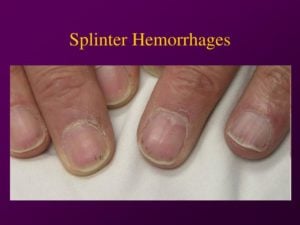Splinter Hemorrhage
What is Splinter Hemorrhage? A splinter hemorrhage is an abnormality that occurs in a person’s nails, either fingernails or toenails, resulting in blood spots underneath the nail. They have the appearance of splinters and usually occur when there is damage to the tiny blood vessels (capillaries) along the nail bed. The nail bed is found […] Read More
Top Doctors For Splinter Hemorrhage Treatments
Top Hospitals For Splinter Hemorrhage Treatments
Splinter Hemorrhage
What is Splinter Hemorrhage?
A splinter hemorrhage is an abnormality that occurs in a person’s nails, either fingernails or toenails, resulting in blood spots underneath the nail. They have the appearance of splinters and usually occur when there is damage to the tiny blood vessels (capillaries) along the nail bed. The nail bed is found underneath the skin. Small amounts of blood from the damaged blood vessels become visible through the nail. The name is borne from the fact that the hemorrhage resembles having a splinter underneath the fingernail. Splinter hemorrhage develops longitudinal reddish streaks down the nails, which are prominent when viewed. Splinter hemorrhages are not painful except for those caused by trauma. They are considered one of the harmless abnormalities that can occur in the body. Picture Courtesy: Slideshare
Picture Courtesy: Slideshare
What are the risk factors for splinter hemorrhage?
The following are susceptible:-
-
- Men experience splinter hemorrhage more often than women.
- People with darker complexions may also have a greater risk.
- People with systemic disease will always have their splinter hemorrhage reappear after treatment, sometimes in different locations. The hemorrhage is usually 1-3mm in length.
-
Treatment
-
-
- When caused by a trauma
-
-
-
- When caused by a medical condition
-
-
-
- Splinter hemorrhage caused by medications.
-
When to see a Doctor
A person should seek medical treatment if the following symptoms accompany their splinter hemorrhage:-
-
- Fever
- Persistent joint pain
- Petechiae, which are red dots on the skin.
-
Best Foods for Splinter Hemorrhage Patients
To prevent splinter hemorrhages, drink plenty of water. Eating a high vitamin B and zinc diet can be a great advantage in making the fingernails grow stronger. It is also good to avoid foods that may trigger the symptoms. For example, if a person is lactose intolerant, they have to avoid milk products or consume them in very small quantities. Avoiding foods containing gluten will be the most effective treatment for celiac disease. Foods with high vitamin B include:-
-
- Milk.
- Cheese.
- Eggs.
- Liver and kidney.
- Meat, such as chicken and red meat.
- Fish, such as tuna, mackerel, and salmon.
- Shellfish, such as oysters.
- Dark green vegetables, like avocadoes, beets, etc.
- Whole grains and cereals.
- Beans like black beans, kidney beans, etc.
- Legumes, such as beans and lentils.
- Nuts and seeds.
- Fruits, such as citrus, banana, and watermelon.
- Soy products, such as soy milk and tempeh.
- Blackstrap molasses.
- Wheat germ.
- Yeast and nutritional yeast.
-
-
-
- Take foods high in Biotin, vitamin B-6, and vitamin B-12.
- Vegetarian-friendly foods are rich in vitamin B-12.
-
-
-
- Shellfish; oysters, crab, mussels, shrimp.
- Legumes; chickpeas, lentils, beans.
- Seeds; hemp, pumpkins, squash, sesame seeds.
- Nuts.
- Dairy.
- Eggs.
-
Symptoms
SYMPTOMS
The primary symptoms of splinter hemorrhage include:
- A small amount of bleeding underneath a nail
- A dark red or brown line along your nail groove
- Dark streaks resembling a splinter
- No pain except trauma
If the underlying cause is trauma or injury, additional symptoms:
- Pains
- Swelling
- Inflammation
- A small amount of blood
Causes
CAUSES
Splinter hemorrhage occurs when blood leaks from small blood vessels that run up and down the nail bed. One of the most common causes of splinter hemorrhage is trauma to the nails.
An estimated 20 percent of splinter hemorrhage is caused by nail trauma. Another cause of splinter hemorrhage is some medical conditions.
Causes of splinter hemorrhage as a result of medical conditions include:
- Infectious endocarditis
- IV drug abuse. Injecting illegal drugs, such as heroin. They have a greater risk of infectious disease.
- Rheumatic heart disease
- The systematic lupus erythematosus(SLE). An autoimmune disorder that causes joint pain, blood clotting, and changes to the circulation in fingers
- Nail psoriasis. An autoimmune disorder that causes excess skin cells to build upon the nails, which can result in the pitting of the nails. At times, the nails will also split or separate from the nail bed.
- Antiphospholipid syndrome. It causes blood clots to develop in the arteries and veins. It may result from lupus or no known condition.
- Medications, in rare instances can be a result of medication. Examples of such drugs include aspirin, warfarin (coumadin), and some chemotherapy medications, such as tetracycline or ganciclovir (Cytovene).
Splinter hemorrhage that has no known cause, is known as idiopathic splinter hemorrhaging.
FAQ
-
- Are splinter hemorrhages serious?
Splinter hemorrhages are usually harmless that can temporarily alter the nail beds. However, an underlying disease can indicate some changes associated with splinter hemorrhages. For instance, the splinter hemorrhages in the case of infective endocarditis indicate a very severe condition.
-
- Can pregnancy cause splinter hemorrhage?
Systemic diseases that can cause splinter hemorrhage may include rheumatoid arthritis, internal malignancy, mitral stenosis, systemic lupus erythematosus, antiphospholipid syndrome, peptic ulcer disease, malignancies, and oral history contraceptive use, pregnancy, and psoriasis.
-
- What happens if you leave blood under the skin?
A simple subungual hematoma typically grows out with the lengthening nail plate and resolves on its own, although sometimes subungual hematomas can result in the nail falling off (onycholysis). However, until the nail grows out, one can expect weeks to months of blue-black discolorations.
-
- What do vertical black lines on the fingernails mean?
A narrow black line formed vertically underneath the nails is called a splinter hemorrhage. It occurs for various reasons and may be harmless or a sign of a more serious health condition. This condition is called a splinter hemorrhage because it may look like a wood splinter under the nail.
-
- How does a person test for endocarditis?
A blood culture test identifies any germs in the bloodstream. Hence, the results from the blood culture test aid the doctor in prescribing the most appropriate antibiotic or combination of antibiotics. A complete blood count may also be recommended. This blood test can tell the doctor if a person has a lot of white blood cells, which can be a sign of infection.










































